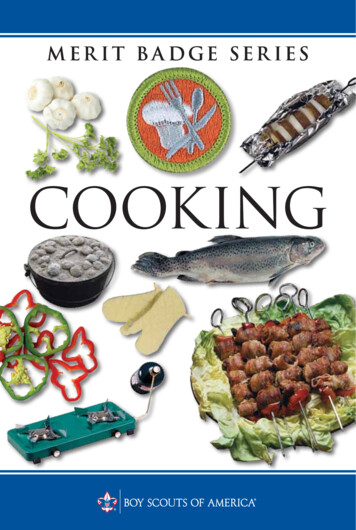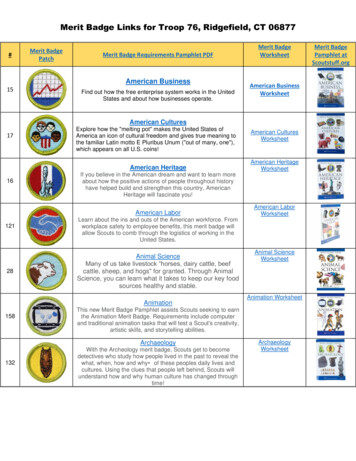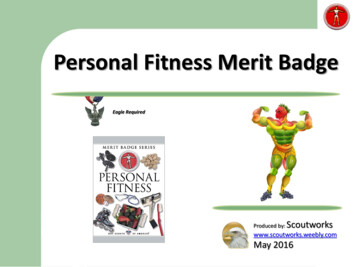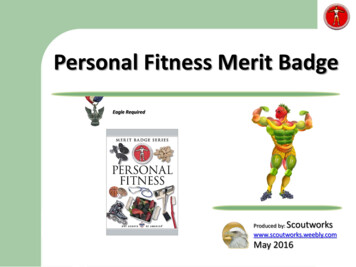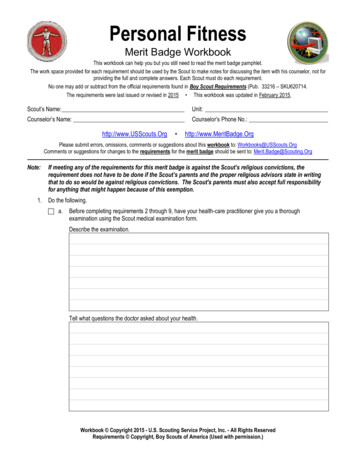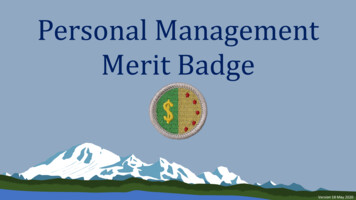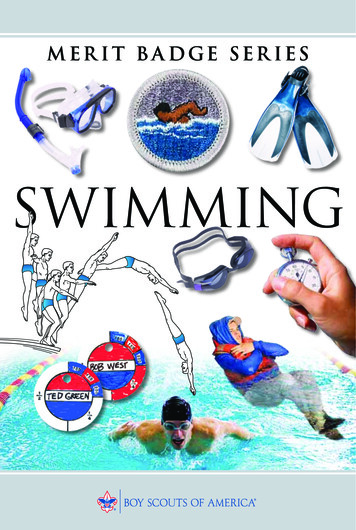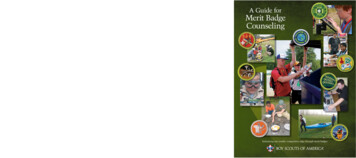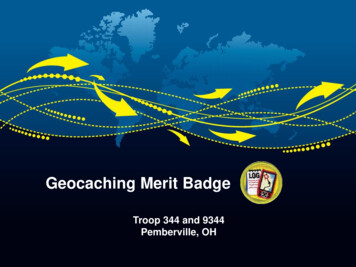
Transcription
Geocaching Merit BadgeTroop 344 and 9344Pemberville, OH
Geocaching Merit Badge Requirements1. Do the following:a. Explain to your counselor the most likely hazards you may encounter whileparticipating in geocaching activities and what you should do to anticipate,help prevent, mitigate, and respond to these hazards.b. Discuss first aid and prevention for the types of injuries or illnesses thatcould occur while participating in geocaching activities, including cuts,scrapes, snakebite, insect stings, tick bites, exposure to poisonous plants,heat and cold reactions (sunburn, heatstroke, heat exhaustion,hypothermia), and dehydration.c. Discuss how to properly plan an activity that uses GPS, including using thebuddy system, sharing your plan with others, and considering the weather,route, and proper attire.2. Discuss the following with your counselor:a. Why you should never bury a cache.b. How to use proper geocaching etiquette when hiding or seeking a cache,and how to properly hide, post, maintain, and dismantle a geocachec. The principles of Leave No Trace as they apply to geocaching
Geocaching Merit Badge Requirements3. Explain the following terms used in geocaching: waypoint, log, cache, accuracy,difficulty and terrain ratings, attributes, trackable. Choose five additional terms toexplain to your counselor.4. Explain how the Global Positioning System (GPS) works. Then, using Scouting'steaching EDGE, demonstrate the use of a GPS unit to your counselor. Includemarking and editing a waypoint, changing field functions, and changing thecoordinate system in the unit.5. Do the following:a. Show you know how to use a map and compass and explain why this isimportant for geocaching.b. Explain the similarities and differences between GPS navigation andstandard map reading skills and describe the benefits of each.
Geocaching Merit Badge Requirements6. Describe the four steps to finding your first cache to your counselor. Then markand edit a waypoint.7. With your parent's permission*, go to www.geocaching.com. Type in your city andstate to locate public geocaches in your area. Share the posted information aboutthree of those geocaches with your counselor. Then, pick one of the three andfind the cache.*To fulfill this requirement, you will need to set up a free user account withwww.geocaching.com. Ask your parent for permission and help before you do so.
Geocaching Merit Badge Requirements8.9.Do ONE of the following:a. If a Cache to Eagle series exists in your council, visit at least three of the 12 locationsin the series. Describe the projects that each cache you visit highlights, and explain howthe Cache to Eagle program helps share our Scouting service with the public.b. Create a Scouting-related Travel Bug that promotes one of the values of Scouting."Release" your Travel Bug into a public geocache and, with your parent's permission,monitor its progress at www.geocaching.com for 30 days. Keep a log, and share thiswith your counselor at the end of the 30-day period.c. Set up and hide a public geocache, following the guidelines in the Geocaching meritbadge pamphlet. Before doing so, share with your counselor a three-monthmaintenance plan for the geocache where you are personally responsible for thosethree months. After setting up the geocache, with your parent’s permission, follow thelogs online for 30 days and share them with your counselor. You must archive thegeocache when you are no longer maintaining it.d. Explain what Cache In Trash Out (CITO) means, and describe how you have practicedCITO at public geocaches or at a CITO event. Then, either create CITO containers toleave at public caches, or host a CITO event for your unit or for the public.Plan a geohunt for a youth group such as your troop or a neighboring pack, at school, or yourplace of worship. Choose a theme, set up a course with at least four waypoints, teach theplayers how to use a GPS unit, and play the game. Tell your counselor about yourexperience, and share the materials you used and developed for this event.
Requirement 1Do the following:a. Explain to your counselor the most likely hazards you mayencounter while participating in geocaching activities and whatyou should do to anticipate, help prevent, mitigate, and respondto these hazards.b. Discuss first aid and prevention for the types of injuries orillnesses that could occur while participating in geocachingactivities, including cuts, scrapes, snakebite, insect stings, tickbites, exposure to poisonous plants, heat and cold reactions(sunburn, heatstroke, heat exhaustion, hypothermia), anddehydration.c. Discuss how to properly plan an activity that uses GPS, includingusing the buddy system, sharing your plan with others, andconsidering the weather, route, and proper attire.6
1a Hazards The most typical hazards you’ll encounter whilegeocaching are:– Unexpected Weather Conditions– Insect Bites/Stings– Dangerous Wild Animals– Excessive Rain/Flooding– Heat-Related InjuriesMany of these issues can be prevented by beingprepared in your packing and can be responded to byremoving the affected person from the hazardousenvironment, then treating them accordingly.7
Geocaching and the InternetSeveral websites offer information about geocaching. Justremember that no one controls the information put on theweb. What you see posted may be incorrect or misleading.Always consider the source of the information to help youevaluate how accurate it might be.Basic Internet Safety:1.2.3.4.Follow your family’s rules for going online. Obey time limits and donot visit areas that are off-limits.Protect your privacy. Never exchange e-mails, give out personalinformation, or send your picture without your parent’s permissionDo not open e-mails or files your receive from people you don’t knowor trust. Delete suspicious items.If you receive or discover any information that makes youuncomfortable, leave it and tell your parents. Do not respond to anymessage that is disturbing or hurtful.8
Geocaching and the InternetBasic Internet Safety (continued):5.6.7.8.9.Never agree to get together with someone you “meet” online, unlessyour parents approve of the meeting and goes with you.Never share your internet passwords with anyone (even if they sound“official”) other than your parents or other responsible adults in yourfamily.Never shop online unless you have your parent’s permission to do so.Do not believe everything you see or read online. Along with lots ofgreat information, the internet has lots of junk. Learn to separate theuseful from the useless.Be a good online citizen. Do not do anything that harms others or isagainst the law.9
Requirement 1Do the following:a. Explain to your counselor the most likely hazards you mayencounter while participating in geocaching activities and whatyou should do to anticipate, help prevent, mitigate, and respondto these hazards.b. Discuss first aid and prevention for the types of injuries orillnesses that could occur while participating in geocachingactivities, including cuts, scrapes, snakebite, insect stings, tickbites, exposure to poisonous plants, heat and cold reactions(sunburn, heatstroke, heat exhaustion, hypothermia), anddehydration.c. Discuss how to properly plan an activity that uses GPS, includingusing the buddy system, sharing your plan with others, andconsidering the weather, route, and proper attire.10
Personal First-Aid KitThe items you carry in your personal first-aid kit will handlemost of the medical problems you are likely to encounterwhile geocaching. Adhesive bandages (6)Sterile gauze pads, 3”x3” (2)Adhesive tape (1 small roll)Moleskin, 3”x6” (1)Hand sanitizing gel (1 travel size bottle)Triple antibiotic ointment (1 small tube)ScissorsNonlatex disposable gloves (1 pair)Mouth barrier devicePencil and paper11
Hypothermia Occurs when body cannot make heat as fast as it loses it. Internal body temperature drops below 95oF. Can occur whenever and wherever a person feels cold,including indoors in poorly heated areas.12
Hypothermia Move victim to shelter. Remove wet clothing andwrap victim in warmcovers. Apply direct body heat. Re-warm neck, chest,abdomen, and groin first. Give warm, sweet drinksif conscious. Monitor breathing,administer CPR. Get medical help.13
Heat Reactions14
Heat Exhaustion Symptoms Heavy sweatingThirstFatigueHeat crampsHeadacheDizzinessNauseaVomiting15
First Aid for Heat Exhaustion Move victim from heat torest in a cool place. Loosen or removeunnecessary clothing. Give water or a sports drink. Raise feet 8-12 inches. Put cool, wet cloths onforehead and body – sprayskin with water. Seek medical care if victim’scondition worsens or doesnot improve within 30minutes.16
Heatstroke17
First Aid for Heat Stroke Call 911. Move victim to coolplace. Remove outer clothing. Cool victim quickly. Apply cold compressesor spray skin with water. Put ice bags or coldpacks beside neck,armpits, and groin.18
Dehydration When the body puts out more liquid than it is taking in. Ways we lose fluids:– Sweating.– Urination.– Vomiting. Signs of dehydration:––––––– Thirst.Yellow or dark urine.Dry mouth.Lightheadedness.Nausea and vomiting.Dry skin.Cease sweating.Treatment:– Drink fluids (water, Gatorade).– Avoid physical activity.– Get inside air conditioned or cool area.19
Insect Bites Bites of mosquitoes and chiggers (harvest mites usually causeitchy, red bumps. The size of the swelling can vary from a dot toa half inch. Signs that a bite is from a mosquito are: itchiness, a centralraised dot in the swelling, a bite on skin not covered by clothing,and summertime, Bites from horseflies, deerflies, gnats, fire ants, harvester ants,blister beetles, and centipedes usually cause a painful, redbump. Fire ant bites change to blisters or pimples within a few hours.20
Treatment of Insect Bites Apply calamine lotion or a bakingsoda paste to the area of the bite. If the itch is severe (as with chiggers),apply nonprescription 1%hydrocortisone cream four times aday. Do not to pick at the bites or they canbecome infected or leave scars. Cold, moist compresses or ice on thearea can help.21
Bee Stings Honey bees, bumble bees,hornets, wasps, and yellowjackets can all sting. These stings causeimmediate painful redbumps. While the pain is usuallybetter in 2 hours, theswelling may increase for upto 24 hours.22
Treatment of Bee Stings If you see a little black dot inthe bite, the stinger is stillpresent (this only occurs withhoney bee stings). Remove it by scraping it offwith a credit card orsomething similar. For persistent pain, massagewith an ice cube for 10minutes. Give acetaminophenimmediately for relief of painand burning. For itching, applyhydrocortisone cream.23
Tick Bites Can transmit Rocky Mountainspotted fever or Lyme disease. Tick embeds its mouth parts inskin and may remain for dayssucking blood.24
Engorged Tick25
Tick Removal Grasp the tick’s mouthpartsagainst the skin, usingpointed tweezers. Pull steadily without twistinguntil you can ease the tickhead straight out of the skin. DO NOT squeeze or crushthe body of the tick. DO NOT apply substancessuch as petroleum jelly, nailpolish, or a lighted match tothe tick while it is attached.26
Tick Removal (cont.) Once you have removedthe tick, wash the woundsite and your hands withsoap and water, and applyrubbing alcohol orantiseptic to the site. Observe the bite over thenext two weeks for anysigns of an expanding redrash or flu-like symptoms(Lyme Disease).Lyme Disease Rash27
Poisonous PlantsCan you identify and namethem?28
Identify Local Poisonous Plants Virginia Creeper issometimes mistakenfor poison ivy.The leaves and vineson the left are VirginiaCreeper and those onthe right are PoisonIvy.29
Poison Ivy RashAverage CaseSevere Case30
Treating Poison Ivy Exposures If you are exposed you shouldquickly (within 10 minutes):– Clean exposed areas withrubbing alcohol.– Wash the exposed areaswith water only first.– Then take a shower withsoap and warm water.Tecnu is a poison oak and ivy scrubthat removes urushiol.Unfortunately, if you wait more than10 minutes, the urushiol will likelystay on your skin and trigger thepoison ivy rash.31
Preventing Poison Ivy The best way to preventPoison Ivy is learn toidentify it and then avoid it!You can avoid a poison ivyrash by:– Wearing long pants anda shirt with long sleeves.– Boots and gloves whenyour most at risk,especially when playingin wooden areas, aroundlakes, or going on hikes.– Apply Ivy-Block toexposed skin.32
Poisonous Snakebite In the U.S. the poisonous snakes arerattlesnakes, copperheads,cottonmouths, and coral snakes. Currently about 8,000 people peryear in the U.S. are bitten by apoisonous snake, of which about 6will die.33
First Aid for Poisonous Snake Bites Have victim lie down and stay calm. Keep bitten area immobile and belowlevel of heart. Call 911. Wash bite wound with soap and water. Remove jewelry or tight clothing beforeswelling. Do not try to catch snake but noteappearance. If possible, wrap entire extremity withelastic (compression) bandage to slowspread of venom. Do not use a tourniquet. Do not cut wound open to try to drain orsuck venom out.34
Blisters A blister is skin injury that is usually filled with water. Blisters commonly occur on the feet or hands. They are most often caused by the hands or feet rubbingagainst something (such as wearing new shoes).35
36
Treatment for Blisters Do not open the blisters, sincethis increases the possibility ofinfection. Clean the skin around it. Take the pressure off the area byplacing a Band-Aid over theblister or Moleskin with a hole cutin the center. If the blister accidentally breaksopen, trim off the loose skin. Keep the surface clean bywashing it twice a day with anantibacterial soap (such as Dialor Safeguard). Apply an antibiotic ointment anda Band-Aid to help with healing.37
Popping a Blister If a blister is in a frequently used area that has ahigh risk of rupturing, it may be best to pop it tomake sure it’s properly protected against infection. Wash your hands and the blister thoroughly. Disinfect a needle with alcohol. Carefully puncture the blister.– Poke three or four shallow holes around the edge of theblister.– You want to keep as much of the skin intact as possible.– Allow the fluid to drain out. Cover the blister with a first aid ointment such asNeosporin. Apply a dressing.– Cover the blister tightly with a bandage or gauze. Repeat if necessary.– You may need to perform these steps every six to eighthours for the first 24 hours.– After that, change the dressing and apply ointment daily.38
Preventing Blisters Friction can also be reduced by wearing two pairs ofsocks. Place Moleskin on sensitive areas were the friction mayoccur.39
Requirement 1Do the following:a. Explain to your counselor the most likely hazards you mayencounter while participating in geocaching activities and whatyou should do to anticipate, help prevent, mitigate, and respondto these hazards.b. Discuss first aid and prevention for the types of injuries orillnesses that could occur while participating in geocachingactivities, including cuts, scrapes, snakebite, insect stings, tickbites, exposure to poisonous plants, heat and cold reactions(sunburn, heatstroke, heat exhaustion, hypothermia), anddehydration.c. Discuss how to properly plan an activity that uses GPS, includingusing the buddy system, sharing your plan with others, andconsidering the weather, route, and proper attire.40
Managing Risk Use the buddy system– When you geocache with a buddy, you watch out for each other. Plan ahead– Know where you are going and what to expect on the trip.– Tell someone where you are going and when you expect to return.– Pack your pack by bringing a personal first-aid kit, a compass,maps, extra batteries for your GPS receiver, water, food, and extraclothing. Watch the weather– Avoid dangerous weather situations such as lightning storms.– Dress appropriately for the weather conditions and take plenty ofwater.41
Requirement 2Discuss the following with your counselor:a. Why you should never bury a cache.b. How to use proper geocaching etiquette when hiding or seeking acache, and how to properly hide, post, maintain, and dismantle ageocache.c. The principles of Leave No Trace as they apply to geocaching.42
Never Bury a Cache A cache should be well hidden,but not impossible to find.You should never alter theenvironment when you hide acache, nor should you place thecache in such a spot thatseekers will have to affect theenvironment when they look forit.Never bury a geocache or placeit in thick brush that others willhave to clear.– Since the accuracy of a GPSreceiver never gets you to theexact spot, too many holeswould be dug searching for aburied container. Burying a geocache violates theprinciples of “Leave No Trace.”43
Requirement 2Discuss the following with your counselor:a. Why you should never bury a cache.b. How to use proper geocaching etiquette when hiding or seeking acache, and how to properly hide, post, maintain, and dismantle ageocache.c. The principles of Leave No Trace as they apply to geocaching.44
Etiquette for Hiding or Seeking a Geocache Practice Cache In Trash Out (CITO). Always carry atrash bag and remove litter along your route.Follow Leave No Trace guidelines in the naturalenvironment.Be careful of the area around the cache – don’t tramplethe grounds, rip up sprinkler heads, etc., in your frenzyto find the cache.Follow all laws and regulations. Never enter privateproperty without permission.Write an entry in the logbook at the cache.Cache items are there for fun and for trade. Try to leavesomething of equal value to what you take for yourself.Respect other visitors around the area.45
Four Steps of Hiding a Geocache1. Research - Carefullyresearch where you wantto place your cache.a.b.c.Are there adequate placesto hide your cache withoutrisk to the environmentwhen people are seekingthem?Are there too many othercaches nearby?Seek out new places tohide caches rather than putthem where others alreadyexist.46
Four Steps of Hiding a Geocache2. Safety – Your cache mustbe in a location that issafe to get to.a.b.Get permission from thelandowner or land manager.Avoid placing cachesanywhere the seekers mightencounter danger (busyintersections, railroadtracks, electric utility boxes,high in trees, areasovergrown with poison ivy,giant mousetraps, etc.)Questionable Hides47
Four Steps of Hiding a Geocache3. The Hunt – Make sure geocachers can find your cache.a.b.c.When placing the cache, can you get a good satellite signal.Make sure your cache can easily be identified as a geocache bywriting “Geocache” on the outside of the container.Consider using a clear plastic container so the contents areeasily identifiable.48
Four Steps of Hiding a Geocache4. The Actual Find – Put your logbook in a waterproof bagalong with a pencil and a note to welcome the cachefinder.a.b.c.Preload the cache with enough prizes for the first few people tofind.Geocaching is a family activity and the contents should besuitable for all ages.Do not include food items.49
Posting a Geocache Log onto www.geocaching.com,click on the “Play” button, choose“Hide a Geocache.”Read through the “How to hide ageocache” articles.When you are certain your cachemeets all the requirements forplacement and you have it inplace, then click on the “Hide aCache” button and fill out the form.Before your cache is posted onGeocaching.com, a volunteer willreview the cache to make sure theGPS coordinates are correct and itmeets the requirements for listing.50
Maintaining a Geocache Once you place a geocache,you have an obligation tomaintain the cache and thearea around it.Monitor the online logs thatare sent to you and act onany reports that your cacheneeds maintenance.If visitors are damaging thelandscape, change thelocation and be sure to alsochange the online listing.51
Dismantling a Geocache Geocaches should not be placed unless you can activelymaintain them for at least six months.To dismantle the cache, physically remove the cachecontainer and any litter that may be around your hidingspot.Go online and archive your cache listing.52
Requirement 2Discuss the following with your counselor:a. Why you should never bury a cache.b. How to use proper geocaching etiquette when hiding or seeking acache, and how to properly hide, post, maintain, and dismantle ageocache.c. The principles of Leave No Trace as they apply to geocaching.53
Leave No Trace1. Plan Ahead and Prepare––––Know and comply with the geocaching policies of the landownersor land management agencies where you wish to seek or lacecaches.Prepare for your trip with proper equipment and clothing for theweather, terrain, and environmental conditions, and foremergencies.Be safe. Let someone know where you will be going and whenyou expect to return.Know how to use your GPS unit. Carry extra batteries and havea map and compass as backup.54
Leave No Trace2. Travel and Cache on Durable Surfaces–––––––Travel on designated trails and roads. Comply with posted signs.If permitted and you must travel off-trail, choose durable surfacessuch as rock, sand, gravel, and dry grass, and spread out toavoid creating new paths.Use maps to find a route that will minimize impacts. Noteway points during your journey to assist you on your return trip.After you have finished searching for a cache, the area shouldlook as though you were never there.Do not place a cache in sensitive locations such as fragilevegetation or soils, critical wildlife habitat, wetlands, lakeshores,alpine areas or caves.Do not place a cache in protected areas such as designatedwilderness areas or wild and scenic river corridors, or nearhistoric and cultural sites.If you notice a path has started to wear in the vicinity of a cache,notify the cache owner to move the cache.55
Leave No Trace3. Dispose of Waste Properly– Cache In, Trash Out. Carry an extra trash bag for trash, leftoverand dropped food, and litter left by others.– Use established bathrooms when available. If not available,deposit solid human waste in catholes dug 6-8 inches deep atleast 200 feet from water sources, campsites, trails, and caches.– Pack out toilet paper and hygiene products in a double plastic bag.56
Leave No Trace4. Leave What You Find– Preserve the past. Observe, but do not touch, cultural or historicstructures and artifacts. Never use artifacts as cache items.– Leave rocks, plants, and other natural objects for others to enjoy.– Practice the “lift, look, replace” technique. If you lift a rock to lookunder it, replace it exactly as you found it.57
Leave No Trace5. Minimize Campfire Impacts– If you plan to have a fire, know the fire regulations and currentguidelines for the area you plant to visit.– This is not often relevant for geocaching, but it is good toremember.58
Leave No Trace6. Respect Wildlife– Observe wildlife from a distance. Do not follow or approachanimals.– Never feed wild animals. Feeding wildlife damages the animals’health, alters natural behaviors, and exposes animals and othergeocachers to predators and other dangers.– Protect wildlife and your food by storing rations and trash securely.– Never leave food of any kind in a cache. Wildlife may find anddestroy the cache, and animals may be harmed by consumingfood wrappers.– Respect wildlife when traveling to and from cache locations. Avoidlocations with significant wildlife traffic, such as water sources.– Keep pets on a leash for their safety and the safety of wildanimals. Consider leaving pets at home.59
Leave No Trace7. Be Considerate of Other Visitors––––Be courteous. Yield to other users on the trail.Take breaks on durable surfaces away from the trail.Let nature’s sounds prevail. Avoid loud voices and noises.Respect the rights and experiences of other visitors. Geocachingis only one of many outdoor recreational activities.– Don’t trespass. When traveling to and from caches, take notice ofprivate property signs.– Practice the principles of Leave No Trace. The future ofgeocaching lies in the hands of geocachers.60
Requirement 3Explain the following terms used in geocaching: waypoint, log, cache,accuracy, difficulty and terrain ratings, attributes, trackable. Choose fiveadditional terms to explain to your counselor.61
Waypoint A Waypoint is a referencepoint for a physical location onEarth.It may be a landmark, adestination, or a point along aroute on the way to reachingthe destination.Waypoints are defined by a setof coordinates that typicallyinclude latitude and longitude(or UTM coordinates), andsometimes altitude.62
Log The Log (logbook, notebook, or log sheet) inside acache contains information from the cache owner andprovides a place for geocachers to write their name andthe date they visited the cache.Space may also be available for visitors to write notes orleave comments for the cache owner.63
Cache and Hide A cache, or geocache, is acontainer hidden at specificcoordinates that includes, ata minimum, a logbook forgeocachers to sign whenthey find the cache.Caches may also contain“treasure,” or items to trade.Hide is a shorthand term fora cache that is hidden.64
Accuracy and Ground Zero Accuracy in geocaching is the degree of closeness to theexact location.– Neither a GPS or smartphone will give you an exact position.– At best, you'll get an accuracy of 10 to 15 feet (3 to 5 meters Ground Zero is the point where your GPS device showsthat you have reached the exact cache location.– In practice, you almost never reach true “ground zero.” (Seeaccuracy.)65
Difficulty and Terrain Ratings Difficulty is a ranking system todescribe how hard the cache is tofind.– A cache that can be found quickly isranked 1 (easiest to find).– A cache that is ranked 5 is exceptionallywell hidden and is hardest to find. Terrain Ratings describe the landfeatures and how hard the cache is toget to.– Terrain that can be traversed in awheelchair has a rating of 1 (flat and easyand not too far.)– A 5 rating probably means it will likelyrequire special equipment such as scubagear or mountaineers’ ropes. See chart on next slide.66
67
Attributes Attributes are icons on a cache detail that are intendedto provide helpful information to geocachers who wish tofind specific types of caches.The icons represent unique cache characteristics68
Trackable A Trackable is anything with a tracking number or otherunique identifier that can be followed as the item travelsfrom cache to cache.69
Clue and Spoiler Clues or hints give the person seeking the cache a littlemore information to help find it.– The cache name, part of the description, or an official hint can allbe clues.– Examples: Tie Your Shoe Bend down and look at a lower level Attractive Magnetic geocache Troll Under a bridge A Spoiler is information that gives away the location ofthe find.70
Being Muggled When someone has broken into a cache and ruined it,that is called “Being Muggled.”71
Travel Bug and Watch List A Travel Bug is an item that travels from cache location tocache location with a trackable number written on a metaltag so you can record on the Geocaching.com websitewhere you picked it up and where you dropped it off.Travel Bugs often have a “mission” of getting to a certainlocation or state.A Watch List is a list of users who are watching a specificTravel Bug or cache.72
Archive If you want to remove your cache from the public listing(or if a reviewer does this for you for lack ofmaintenance), it is “Archived.”You can also temporarily disable a cache if you need toinactivate it for a short time.73
Reviewer Reviewers are volunteersfrom all over the world checknew listings for various issues(making sure the cachefollows the guidelines) andthen publish the cachelistings on Geocaching.com.74
Acronyms CITO – Cache In Trash Out. In this geocaching event,people do cleanup for parks or the community.DNF – Did Not Find. Geocachers use this acronym tostate that they did not find a cache. If you get severalDNF responses for a cache you set up, it’s time to checkon it!FTF – First To Find. This acronym is used when loggingcache finds to denote being the first to find a newgeocache.GC – Geocache Code. Each code assigned to publicgeocache listings is unique.Other common acronyms often written in logs:––––TFTC – Thanks For The CacheTFTH – Thanks For The HideTNLN – Took Nothing Left NothingTNSL – Took Nothing Signed Log75
Types of Caches Traditional Cache – An ordinary hide with a singlecache found at the given coordinates.Multi Cache – This type of cache has more than onepart. You may find the coordinates of the second cachein the first, and so on.Mystery or Puzzle Cache – The actual cache is not atthe coordinates that are listed on the website. Instead,there is a puzzle that must be solve to lead to the actualsite.76
Types of Caches Letterboxing (www.letterboxing.org) – A form oftreasure hunting that uses clues to direct the seekers toa hidden container. Each container has a unique stampthat you use to mark your logbook and you leave yourown unique stamp in the letterbox logbook. Do not takethe stamp from the letterbox.77
Requirement 4Explain how the Global Positioning System (GPS) works. Then, usingScouting's teaching EDGE, demonstrate the use of a GPS unit to yourcounselor. Include marking and editing a waypoint, changing fieldfunctions, and changing the coordinate system in the unit.78
How Does the GPS System Work? A GPS receiver calculates its position by carefully timingthe signals sent by the 31 orbiting GPS satellites.Each satellite continually transmits data that indica
Geocaching Merit Badge Requirements 1. Do the following: a. Explain to your counselor the most likely hazards you may encounter while participating in geocaching activities and what you should do to anticipate, help prevent, mitigate, and respond to these hazards. b. Discuss first aid a
